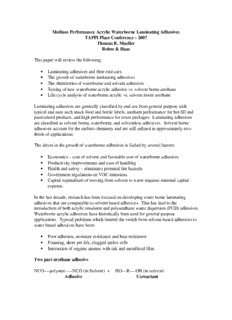
Medium Performance Acrylic Waterborne Laminating Adhesives TAPPI Place Conference PDF
Preview Medium Performance Acrylic Waterborne Laminating Adhesives TAPPI Place Conference
Medium Performance Acrylic Waterborne Laminating Adhesives TAPPI Place Conference – 2007 Thomas R. Mueller Rohm & Haas This paper will review the following: • Laminating adhesives and their end uses. • The growth of waterborne laminating adhesives • The chemistries of waterborne and solvent adhesives • Testing of new waterborne acrylic adhesive vs. solvent borne urethane • Life cycle analysis of waterborne acrylic vs. solvent borne urethane Laminating adhesives are generally classified by end use from general purpose with typical end uses such snack food and bottle labels, medium performance for hot fill and pasteurized products, and high performance for retort packages. Laminating adhesives are classified as solvent borne, waterborne, and solventless adhesives. Solvent borne adhesives account for the earliest chemistry and are still utilized in approximately two- thirds of applications. The driver in the growth of waterborne adhesives is fueled by several factors: • Economics – cost of solvent and favorable cost of waterborne adhesives • Productivity improvements and ease of handling • Health and safety – eliminates potential fire hazards • Government regulations on VOC emissions • Capital expenditure of moving from solvent to water requires minimal capital expense. In the last decade, research has been focused on developing water borne laminating adhesives that are comparable to solvent based adhesives. This has lead to the introduction of both acrylic emulsion and polyurethane water dispersion (PUD) adhesives. Waterborne acrylic adhesives have historically been used for general purpose applications. Typical problems which limited the switch from solvent based adhesives to water based adhesives have been: • Poor adhesion, moisture resistance and heat resistance • Foaming, short pot life, clogged anilox cells • Interaction of organic amines with ink and metallized film. Two part urethane adhesive NCO----polymer-----NCO (in Solvent) + HO---R----OH (in solvent) Adhesive Coreactant Drying Curing -------(cid:198) --------(cid:198) -------polymer –NH-CO-O-polymer------ Polyurethane Adhesive: - Isocyanate (NCO) terminated polyether or polyester urethane dissolved in solvent - Molecular weight: 1,000-50,000 Coreactant: - Hydroxyl (OH) terminated polyester or polyether dissolved in solvent This chemistry offers high crosslink density which provides the lamination with good product and heat resistance. Waterborne chemistry is an emulsion polymer made through free radical polymerization of acrylic monomers in water. This chemistry allows for the film formation of the adhesive. In comparison this results in the following: Waterborne acrylic Solvent borne urethane - high molecular weight - low molecular weight - low viscosity - high viscosity - high application solids - low application solids A series of tests were run comparing seal strength, interbond adhesion and heat and moisture resistance. In all cases the waterborne chemistry provided similar performance to that of the solvent based adhesive. Another application that requires unique properties is fresh produce packaging. While solvent borne adhesives can effect the critical oxygen transmission rate of the laminate, the oxygen transmission rate is not effected whatsoever when water based technology is utilized. Life cycle inventory (LCI) is the quantification of energy/material inputs and environmental impacts of a material or operation over its life cycle. An LCI study of waterborne vs. solventborne adhesives was initiated with the following results: MJ/Ream Laminated Solvent-borne Water-borne Feedstocks 70.9 36.0 Transportation 5.7 2.4 Electricity Generation 45.7 11.6 Drying Oven 69.1 88.4 Other Direct Fuel Use 117.1 20.4 Total Energy 308.4 158.7 From this study, the overall performance of waterborne adhesives and solvent borne adhesives is very comparable. Life cycle inventory analysis shows that energy use, carbon dioxide emission and water use are much less for waterborne laminating adhesive when compared to solvent borne adhesives. 2007 PLACE Conference September 16-20 St Louis, MO Medium Performance Acrylic Waterborne Laminating Adhesives Presented by: Tom Mueller Technical Service Manager Agenda • Laminating Adhesive and its End-use • Growth of Waterborne Laminating Adhesive • Chemistry Difference between Solvent Borne Urethane and Water-borne Acrylic • Test Results of New Waterborne Acrylic vs. Solvent borne Urethane • Life Cycle Analysis of Waterborne Acrylic vs. Solvent Borne Urethane Laminating Adhesive Classified by End-Use • Medium performance laminating adhesive – Good adhesion on film/film and film/foil – Good product resistance and moisture resistance for hot fill and pasteurization – Typical end-use: • frozen food, fruit juice, meat, detergent packaging, medical packaging – Structures: • PET/Al/PE, • PET/PE, • Nylon/PE, Laminating Adhesive Classified by End-Use • High performance laminating adhesive – High heat and moisture resistance for retort applications – Typical end-use: MRE, ready-to-eat meal, pet food and medical packaging – Structure: • PET/Al/CPP, • PET/Al/OPA/CPP, • PET/CPP Laminating Adhesive Classified by End-Use • General purpose dry bond laminating adhesive – Good adhesion on plastic and metallized films – Typical end-use: • Snack food • Bottle label – Structures: • OPP/OPP, OPP/PE, • OPP/metOPP, PET/PE, Laminating Adhesive Classified by Solvent/Carrier • Laminating adhesive – Solvent borne adhesive – Solventless adhesive – Waterborne adhesive 8% 25% Solvent borne Solventless Waterborne 67% Solvent Borne Adhesive • Solvent borne adhesive is the most widely used technology for flexible packaging laminating adhesives. – Based on urethane technology. – Long history of product development. – Provides good adhesion and performance to meet requirements from general to high performance food packaging. – Offers good adhesion, good product resistance and heat resistance.
Description: